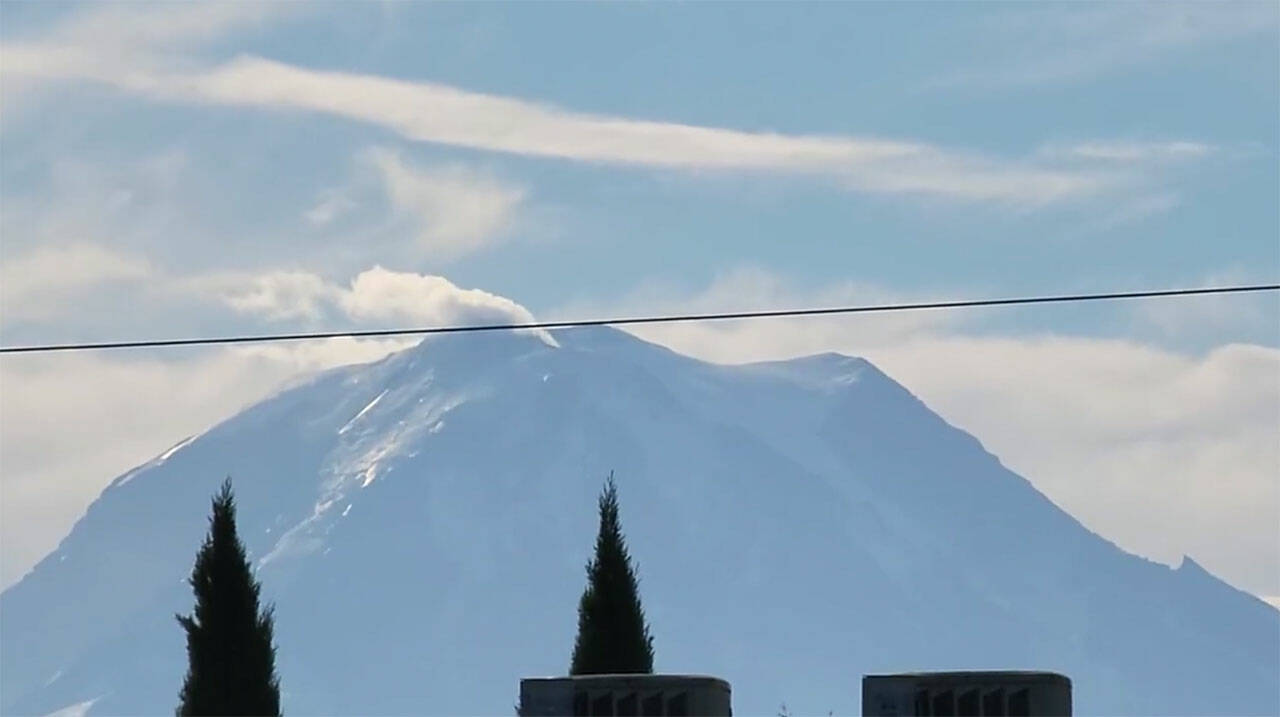A video apparently showing Mount Rainier venting gas grabbed a lot of attention last week.
Luckily for those who live around the active volcano, there was no venting or any kind of volcanic activity — just a passing cloud.
The short clip, posted by a KOMO meteorologist on Twitter around 9:45 a.m. on Sept. 7, appeared to show some sort of gas escaping the Plateau’s most famous landmark, near the peak; the video was watched more than 929,000 times since Sept. 12.
The clip garnered the attention of the the United States Geological Survey and Mount Rainier National Park, and they quickly responded to the news.
“This is a cloud on the top of #MountRainier,” the USGS Volcanoes Twitter account posted. “It’s not erupting or venting.”
“Mount Rainier is NOT erupting,” the MountRainierNPS Twitter account posted. “We have looked at the cloud that has caused concern from multiple webcams and have determined that it is a lenticular cloud.”
The ever-sassy WA Emergency Management Twitter account also weighed in.
“Mt. St. Helens just sitting there today, like, all y’all freaking out about clouds around Mount Rainier when St. Helens’ track record shows it has a much more likely chance of erupting again,” their post reads along with a graphic showing Mount St. Helens has erupted many times more than Mount Rainier over the last 4,000 years. “We do have five active volcanoes in this state.”
While the mountain was not venting — at least at that time — it’s not uncommon behavior for the mountain, and normally isn’t a cause for alarm.
“Does the mountain vent? Yes. It’s a volcano,” Terry Wildly of Mount Rainier National Park said in an interview after officials confirmed Mount Rainier wasn’t going to blow. “Are you going to see it? Maybe… most of the time, you’ve got to be up there, to be up close, to see any of it.”
Wildly added that if the mountain was actually venting at the levels the original video appeared to show, volcano observers would already be prepared.
“If there was going to be that much volume, that you can see it from that far away, then we’re going to know about that weeks ahead of time,” she continued. That would “create all kinds of seismic activity that’s going to set off all the alarm bells… we’ve got 17 volcano monitoring systems. This is one of the most well-monitored volcanos in the United States. We’re not going to get surprised if it’s venting that much.”
And even if Mount Rainier was venting to that level, Wildly said that’s not necessarily a sign of imminent eruption, though the NPS and USGS would take such an event seriously.
WILL RAINIER ERUPT AGAIN?
Probably.
Mount Rainier may be beautiful, but there’s a reason it’s so closely watched by volcano experts — the USGS rates it as “potentially the most dangerous volcano in the Cascade Range because of its great height, frequent earthquakes, active hydrothermal system, and extensive glacier mantle.”
If, or when, the volcano explodes, it will likely not resemble Mount St. Helens’ eruption. Instead of lava flows and ash fall, the danger will come from lahars, a muddy slurry of melted ice, rocks, and other debris that can travel as fast as 50 miles per hour, destroying everything in its path.
Experts believe a major lahar will go down the west side of Mount Rainier and flow along the Puyallup River, putting Orting right in its path, leaving Enumclaw and Buckley be.
When Mount Rainier may erupt again is unknown. The last major eruption, called the Electron Mudflow, was 500 years ago; a lahar swept down the west side of the mountain, and debris went at least as far as Sumner.
The mountain may have also had “steam explosions” in the 1840s or ’50s, but accounts of volcanic activity were varying, and the USGS says “Evidence of 19th century steam explosions or eruptions from the summit of Mount Rainier… is both scanty and tenuous.”
That said, geographical evidence shows the volcano’s last five confirmed eruptions happened about 500 years apart — meaning we could be due for one — but experts have said that volcanos have their own timetable, and don’t happen like clockwork.
HOW TO PREPARE FOR AN ERUPTION
September happens to be Preparedness month, so here are some ways to prep for such an emergency.
Wildly said one of the best ways to prepare for Mount Rainier erupting is to subscribe to the USGS’ volcano notification service.
Those who want to receive notifications via email can head to volcanoes.usgs.gov/vns2/ to create an account.
The Wireless Emergency Alerts system can also alert you about an eruption; head to mil.wa.gov/alerts#volcano for general instructions.
When it comes to evacuating an area due to an eruption or lahar, or really, any emergency, the CDC recommends already having an evacuation plan and emergency supply kit containing a flashlight (and batteries), first aid kit, emergency food and water, manual can opener, one week-supply of essential medications, sturdy shoes, masks, eye protection, and a radio.


